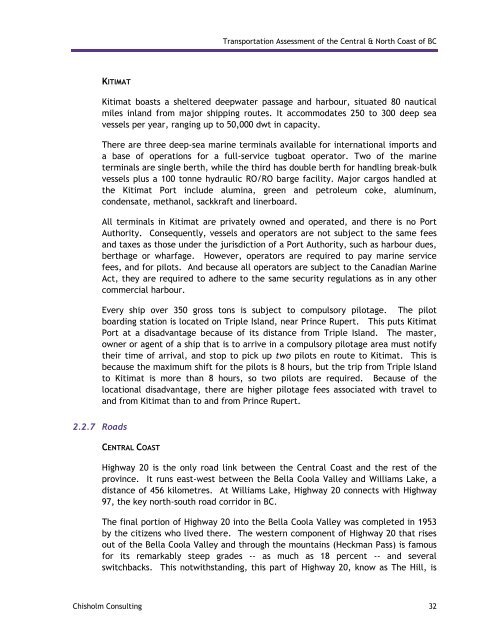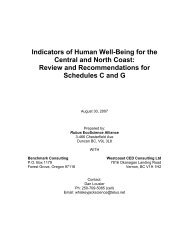Final report - Integrated Land Management Bureau
Final report - Integrated Land Management Bureau
Final report - Integrated Land Management Bureau
Create successful ePaper yourself
Turn your PDF publications into a flip-book with our unique Google optimized e-Paper software.
KITIMAT<br />
2.2.7 Roads<br />
Transportation Assessment of the Central & North Coast of BC<br />
Kitimat boasts a sheltered deepwater passage and harbour, situated 80 nautical<br />
miles inland from major shipping routes. It accommodates 250 to 300 deep sea<br />
vessels per year, ranging up to 50,000 dwt in capacity.<br />
There are three deep-sea marine terminals available for international imports and<br />
a base of operations for a full-service tugboat operator. Two of the marine<br />
terminals are single berth, while the third has double berth for handling break-bulk<br />
vessels plus a 100 tonne hydraulic RO/RO barge facility. Major cargos handled at<br />
the Kitimat Port include alumina, green and petroleum coke, aluminum,<br />
condensate, methanol, sackkraft and linerboard.<br />
All terminals in Kitimat are privately owned and operated, and there is no Port<br />
Authority. Consequently, vessels and operators are not subject to the same fees<br />
and taxes as those under the jurisdiction of a Port Authority, such as harbour dues,<br />
berthage or wharfage. However, operators are required to pay marine service<br />
fees, and for pilots. And because all operators are subject to the Canadian Marine<br />
Act, they are required to adhere to the same security regulations as in any other<br />
commercial harbour.<br />
Every ship over 350 gross tons is subject to compulsory pilotage. The pilot<br />
boarding station is located on Triple Island, near Prince Rupert. This puts Kitimat<br />
Port at a disadvantage because of its distance from Triple Island. The master,<br />
owner or agent of a ship that is to arrive in a compulsory pilotage area must notify<br />
their time of arrival, and stop to pick up two pilots en route to Kitimat. This is<br />
because the maximum shift for the pilots is 8 hours, but the trip from Triple Island<br />
to Kitimat is more than 8 hours, so two pilots are required. Because of the<br />
locational disadvantage, there are higher pilotage fees associated with travel to<br />
and from Kitimat than to and from Prince Rupert.<br />
CENTRAL COAST<br />
Highway 20 is the only road link between the Central Coast and the rest of the<br />
province. It runs east-west between the Bella Coola Valley and Williams Lake, a<br />
distance of 456 kilometres. At Williams Lake, Highway 20 connects with Highway<br />
97, the key north-south road corridor in BC.<br />
The final portion of Highway 20 into the Bella Coola Valley was completed in 1953<br />
by the citizens who lived there. The western component of Highway 20 that rises<br />
out of the Bella Coola Valley and through the mountains (Heckman Pass) is famous<br />
for its remarkably steep grades -- as much as 18 percent -- and several<br />
switchbacks. This notwithstanding, this part of Highway 20, know as The Hill, is<br />
Chisholm Consulting 32

















